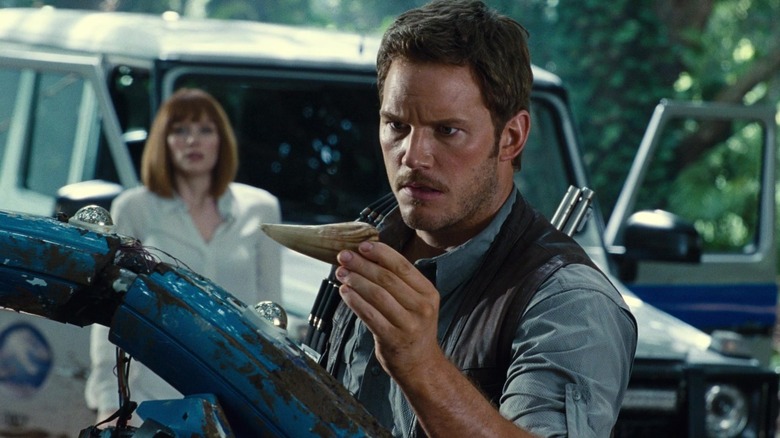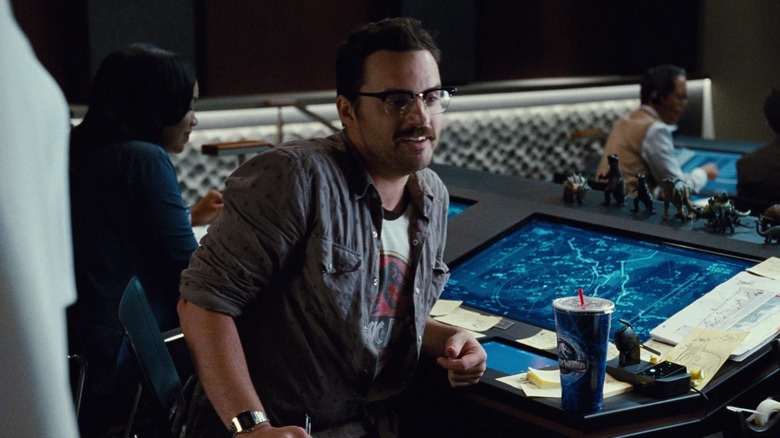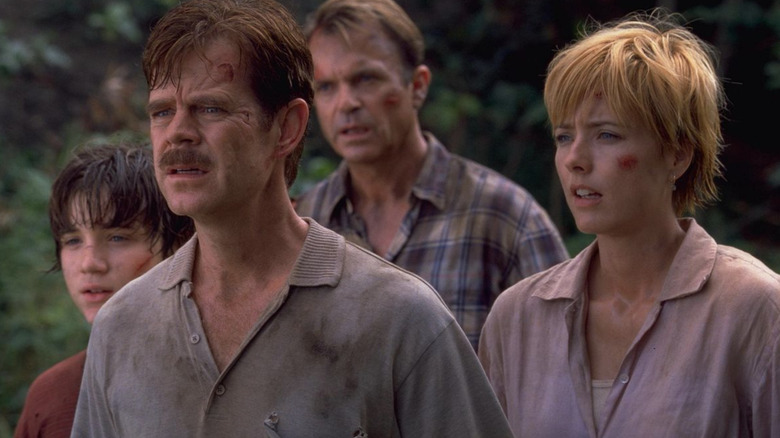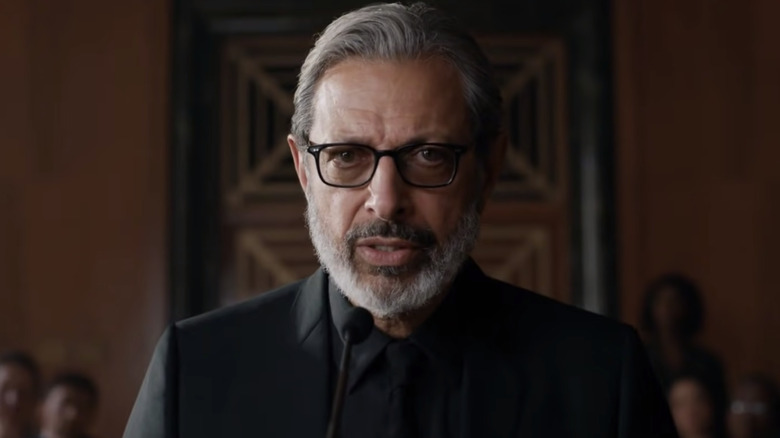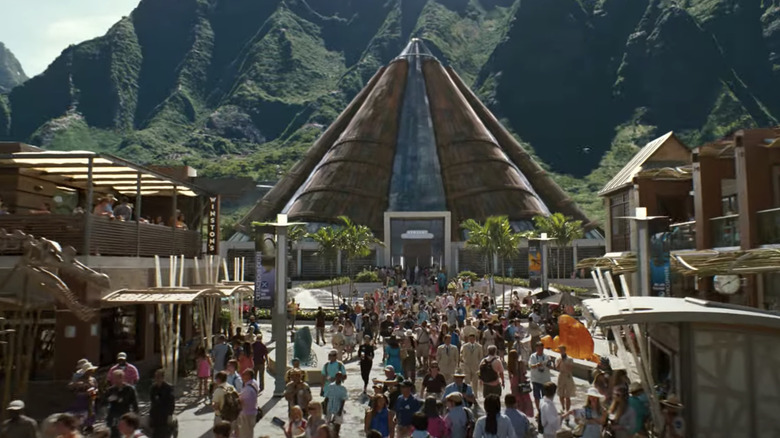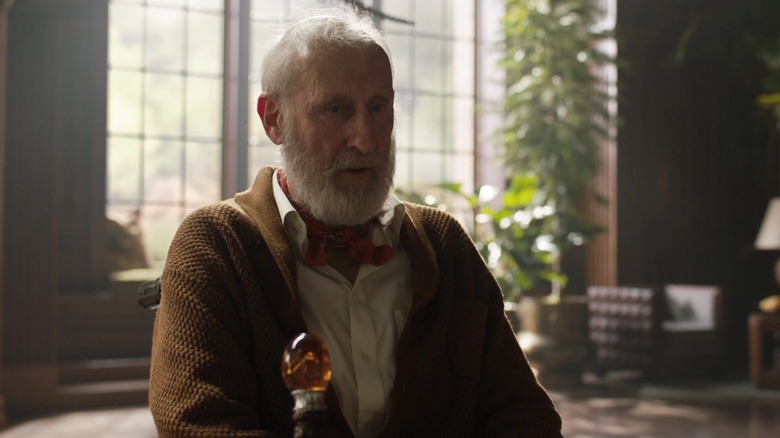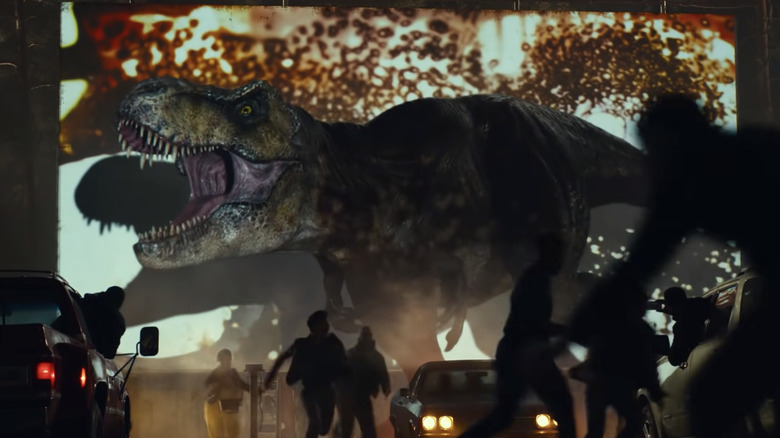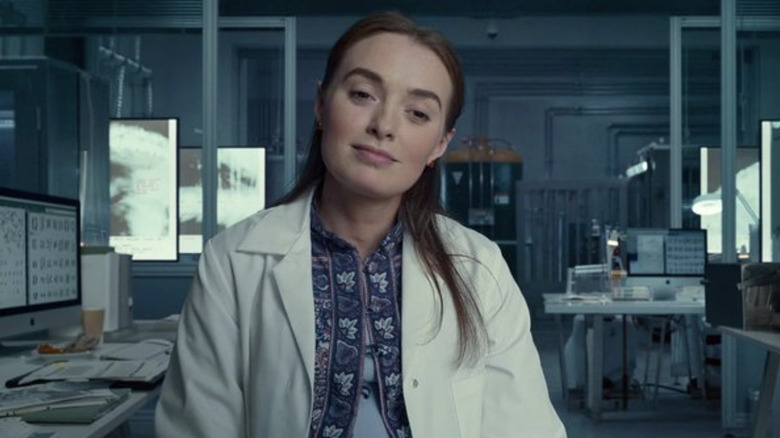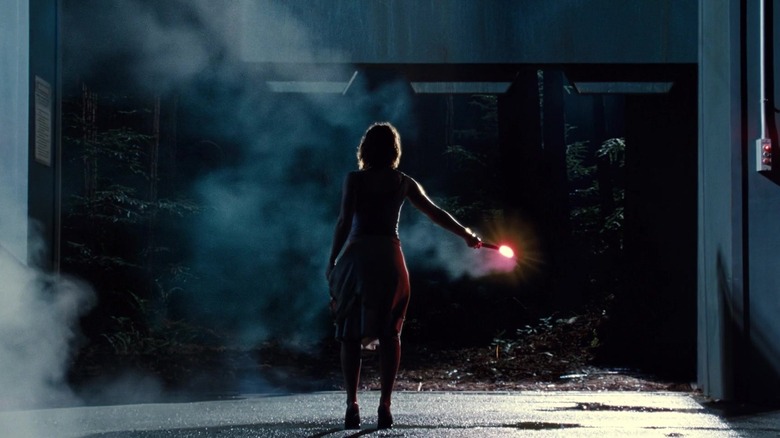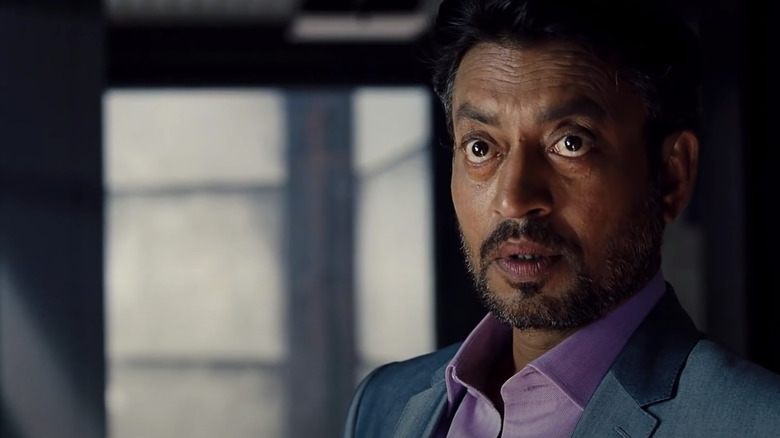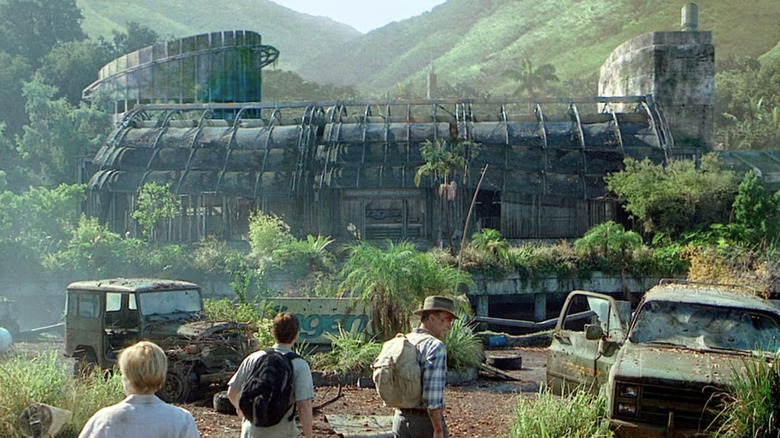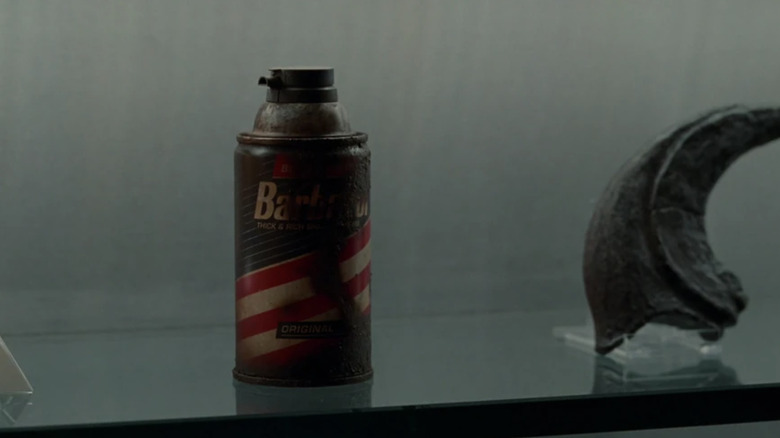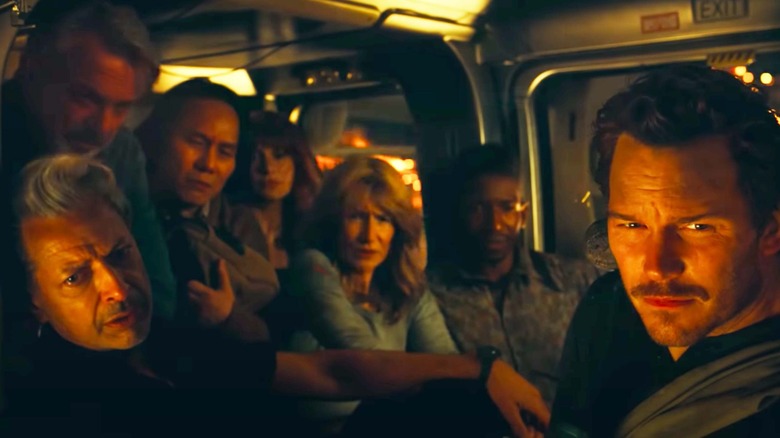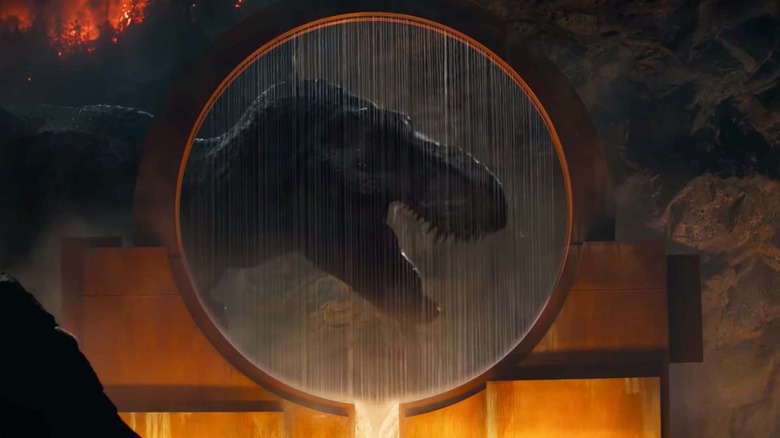Things You Only Notice In The Jurassic World Trilogy The Second Time Around
After a 14-year hiatus, the "Jurassic Park" franchise found new life in Colin Trevorrow's 2015 return to Isla Nublar in "Jurassic World." The first of a new "Jurassic World" trilogy, the film re-introduced John Hammond's (Richard Attenborough) vision for a theme park about dinosaurs complete with unfettered commercialism and new faces to take the story in a new direction. Rather than returning to a dinosaur-infested island to save an unsuspecting visitor, as was the premise of "The Lost World: Jurassic Park" and "Jurassic Park III," these sequels center around the impact the return of dinosaurs would have on society, nature, and the rest of our world.
Headlined by Chris Pratt and Bryce Dallas Howard as Owen Grady and Claire Dearing, Trevorrow's new vision for the "Jurassic" franchise was mixed with material from the original Michael Crichton novels and plenty of nostalgia for Steven Spielberg's first two classics. While the critical responses to each new "Jurassic World" installment varied, there's no denying that these movies delivered, with each installment surpassing $1 billion at the box office. You just can't keep a good dinosaur down.
Folks who've only watched each "Jurassic World" once might have missed a few surprises and recurring motifs along the way, but don't worry, we're here to shed some light on a number of them.
All those Jurassic Park callbacks
It's not hard to catch most of the "Jurassic Park" callbacks in the "Jurassic World" trilogy — they're pretty much everywhere you look, from Lowery Cruthers' (Jake Johnson) vintage T-shirt to the return of the original cast in "Jurassic World Dominion" — but there are a few others stealthily peppered throughout. For starters, Dr. Ian Malcolm's (Jeff Goldblum) "chaos theory" makes an interesting comeback in the first "Jurassic World." In "Jurassic Park," Malcolm explains that, like a drop of water on a hand, chaos theory presupposes that another drop will take a strikingly different path.
Well, in "Jurassic World," it does, only it's not a drop of water but a drop of blood. After the Indominous rex escapes, two drops of blood fall on security officer Hamada's (Brian Tee) hand, each drop taking a different path. Of course, this isn't the only callback to the original "Jurassic Park" trilogy. We also see that road flares still work to lead away a Tyrannosaurus rex, John Hammond's name and image are noted countless times, and the first movie even shows a Spinosaurus skeleton in reference to "Jurassic Park III."
But the callbacks really arrive in full force in "Dominion," which brings back Dr. Alan Grant (Sam Neill) and Dr. Ellie Sattler (Laura Dern), who both endlessly mention trademark moments from the original. Surprisingly, "The Lost World: Jurassic Park" is also referenced here, with a recreation of the violent "blood on the ferns" moment from Steven Spielberg's original sequel.
Not much time has passed since Jurassic Park III
The very first "Jurassic World" is set 22 years after the original "Jurassic Park," which isn't really that long when you consider that the 2015 revival only came out about a decade ago. Likewise, "Jurassic Park III," the original finale of the "Jurassic" franchise, takes place in 2001, only 14 years before the events of "Jurassic World." So for Simon Masrani (Irrfan Khan) to take over Isla Nublar and clear it to build the massive theme park resort (complete with new dinosaurs to boot), it wouldn't be an overnight process.
To make matters more complicated, the in-canon young-adult novel "The Evolution of Claire," written by Tess Sharpe, explains that Jurassic World opened on May 30, 2005, only four years after the events on Isla Sorna in "Jurassic Park III." So how did Masrani make this happen? According to the official (albeit fictional) Masrani Global Corporation website, Hammond's InGen was acquired by Masrani in 1998, just a year after Hammond's death. The first "Jurassic World" makes note of this when Masrani mentions that his father and Hammond were friends.
While a four-year construction for Jurassic World might seem far-fetched, it's entirely plausible. Walt Disney World, after all, only took two years to construct, and with Masrani's massive budget and a host of dinosaurs already on Isla Nublar, it's not as crazy as it sounds. Still, it seems in poor taste to build a new Jurassic Park — err, World — so soon after Hammond's death.
Ian Malcolm shows up in all three
The return of the original "Jurassic Park" cast in "Jurassic World Dominion" was certainly part of the overall excitement surrounding the final installment, but the franchise had teased the return of fan-favorite characters for years beforehand. Despite appearing in the first two "Jurassic Park" movies, Jeff Goldblum didn't return for "Jurassic Park III," even when his original co-stars Sam Neill and Laura Dern did. But he wouldn't make the same mistake with "Jurassic World." Aside from his main cast member status in "Dominion," Goldblum's Dr. Ian Malcolm cameos in the first two films as well.
Of course, his speech at the end of "Jurassic World: Fallen Kingdom" is of note, after dinosaurs are released onto North American soil, but did you realize that he makes a quick appearance in the first "Jurassic World" too? Malcolm's book, "God Creates Dinosaurs," is seen not once in "Jurassic World," but twice. The first time, the character's face appears behind Zach Mitchell (Nick Robinson) on the train as Zara (Katie McGrath) reads it, only to lead to another close-up of the book later on. Either way, Goldblum teases his return throughout the trilogy, culminating in about 10 minutes of "Jurassic World" screen time, give or take, by the time "Dominion" rolls around.
Winston's Steakhouse
Another blink-and-you'll-miss-it cameo in the first "Jurassic World" is a bit deeper of a reference, but one fans of the "Jurassic" franchise will likely appreciate. While touring the overly commercialized Jurassic World, a two-floor steakhouse called "Winston's" can be seen in the background. What seems at first like another food chain that has made it to Isla Nublar (which also has a Margaritaville, Ben & Jerry's, and a Dave & Busters) is actually a clever nod to special effects artist Stan Winston.
Winston worked on all three of the original "Jurassic Park" films and was instrumental in building the animatronic dinosaurs used in them. For "The Lost World," Winston and his team sculpted the largest creation that Stan Winston Studios ever produced at the time, a 20-foot-tall T. rex that was used on set during production. It's an impressive piece of work that still holds up well today. Aside from his contributions to the "Jurassic" franchise, Winston is also known for his work on the "Terminator" films, "Aliens," "The Thing," "Predator," and "Iron Man," which was one of his last works before his death in 2008. No wonder Trevorrow and his team wanted to honor his past work on the "Jurassic" series too.
Where was Lockwood in the original trilogy?
Played by James Cromwell, Sir Benjamin Lockwood first appears in "Jurassic World: Fallen Kingdom," and his inclusion in the "Jurassic" canon is a bit problematic when you think about it. Said to be a close friend of John Hammon's and the original co-founder of InGen, Lockwood only appears in "Fallen Kingdom," with a brief mention again in "Dominion." While that's not an issue in itself, it becomes one when we realize that Lockwood was involved in the creation of the original Jurassic Park, though he isn't ever mentioned in the original 1993 movie.
To make matters more confusing, "Fallen Kingdom" explains Lockwood's absence as being due to the fact that he wanted to clone his deceased daughter, Charlotte (Elva Trill), but that doesn't seem to be possible. In "Dominion," we learn that Maisie (Isabella Sermon) isn't a clone of Charlotte, but rather her genetically created daughter, meaning the entire story (and likely the conflict between him and Hammond) was fabricated.
Furthermore, though Hammond gave Simon Masrani his blessing to buy InGen, as the company's co-founder (and likely among its primary investors), Lockwood would've needed to give his own blessing too. When you think about Hammond and Lockwood's professional relationship behind the scenes and InGen's ultimate buy-out, Masrani's ownership of the company doesn't make a lick of sense considering Lockwood's own fortune. Maybe the death of his daughter impacted him so deeply that he no longer cared about the genetic engineering company, but his actions in "Fallen Kingdom" seem to imply otherwise.
There are two short films set between Fallen Kingdom and Dominion
When "Jurassic World: Fallen Kingdom" ends, dinosaurs are let loose on the world. Unsurprisingly, this results in exactly what you'd expect: pure pandemonium. A post-credits scene at the end of "Fallen Kingdom" even shows a group of pterodactyls swooping over the skies of Las Vegas. But that's not all. A year after the release of the sequel, "Jurassic World" director and trilogy co-writer Colin Trevorrow directed a short film titled "Battle at Big Rock," which tells the story of a blended family camping in Northern California who have to survive a dinosaur encounter.
The 10-minute short first premiered on FX and was later released online, ending with a montage of found footage-style clips showcasing this brave new world. Additionally, those who have seen the extended cut of "Jurassic World Dominion" might note that there's a brand new prologue that opens up the movie. Originally cut from the film, this prologue was released as a short film of its own shortly after the release of "Dominion" in theaters, only to be added back into the extended edition later on. We aren't complaining, though; we'll take all the dinosaur material we can get.
Forget the dinosaurs, the scientific breakthroughs of Jurassic World are much bigger
There's no denying that we watch "Jurassic World" for the dinosaurs. Who doesn't want to see a 65 million-year-old creature walk among humans? But despite the novelty of the dinos themselves, there are other scientific breakthroughs seen throughout the "Jurassic World" trilogy that are even more impressive. For starters, "Fallen Kingdom" introduces the idea of successful human cloning. While cloning itself has been around since the 1990s — and even human cloning has reportedly been dabbled with — Maisie, the cloned girl introduced in the film, is a scientific marvel.
That is, until "Dominion" backtracked on the cloning idea entirely, revealing instead that Maisie was actually asexually reproduced by her mother who experimented on herself in an effort to birth a child. Either way, it's an amazing breakthrough. Additionally, Dr. Lewis Dodgson (Campbell Scott) and Dr. Henry Wu (B.D. Wong) are able to genetically engineer locusts with dinosaur DNA to specifically target the world's crops, and Dodgson even maintains a functional hyperloop transportation system below his compound.
Of course, these aren't the only high-tech advancements seen throughout the trilogy, which also includes holograms, Gyrospheres, and an enormous tank to house the Mosasaurus. But the genetic engineering and state-of-the-art hyperloop system really make us wonder what the priorities of some of these scientists actually are. Dinosaurs aren't all there is, you know.
It takes a while for Claire to ditch the heels
Oddly enough, fans of the first "Jurassic World" heavily criticized the flick because of Claire's unrealistic use of high heels throughout the theme park catastrophe. Sure, a superhero like Wonder Woman wearing heels into battle makes sense, but they might not be the best footwear for running away from angry dinosaurs. Nevertheless, Claire rocked the look throughout the first movie, and despite claims that it was director Colin Trevorrow's decision, actress Bryce Dallas Howard claimed credit for keeping Claire's heels intact, even when others thought otherwise.
"There was a point where we had to decide. I remember that day when I said, 'I'm going to keep these shoes on, please,'" Howard explained (via USA Today). But for the sequel, "Fallen Kingdom," it was written in the original screenplay that Claire would be wearing sneakers upon her introduction. "I was like, 'No, no, no, no. I am going to wear heels. That's what I am going to do,'" Howard said, believing that it signified the completion of her character's journey. Thankfully, Clarie wears boots when returning to Isla Nublar in the sequel, a cosmetic choice that carries on into "Dominion" as well.
Removing sunglasses means something big is coming
Sunglasses are a big deal in the "Jurassic" franchise. From the very first "Jurassic Park," Ellie Sattler removes her shades to catch a better glimpse of the newly created dinosaurs that roam the plains of Isla Nublar, and she's not the only one. This motif is carried on into the "Jurassic World" trilogy as well, and from the very first installment, we know that removing one's sunglasses means something big is coming. Upon being introduced to the Indominous rex, Simon Masrani takes off his glasses to catch a better glimpse of the dinosaur, signaling its importance later.
But this isn't the only time Masrani does this in his time on screen. Just before his death in a helicopter crash, Masrani takes them off once more while piloting the aircraft, hoping to keep it from crashing. Tragically, it wrecks anyway as a direct result of the Indominous rex's actions, with Masrani counted as one of the many casualties of the 2015 Jurassic World incident. Years later, Ellie Sattler does the same thing upon seeing the effects of Biosyn's locust swarm in "Jurassic World Dominion," which leads her back to Alan Grant and the dinosaurs she's tried so hard to avoid.
We never return to Isla Sorna
In "The Lost World," it's revealed that before John Hammond and InGen settled on Isla Nublar as the perfect location for their dinosaur-themed tourist attraction, they spent years on a nearby island deemed "Site B," where they crafted their dinosaurs from the cell up. The island, Isla Sorna, became the primary setting for both "The Lost World" and "Jurassic Park III" as it featured more dinosaurs and less infrastructure, making it the perfect location for more life-threatening adventures.
But when Jurassic World opened, the story returned to Isla Nublar, where it stayed for at least part of the first two "Jurassic World" films before moving to the mainland. And we never see Isla Sorna again. The island is name-dropped in "Fallen Kingdom" and again in "Dominion" as one of the locations from which Biosyn pulled its large collection of dinosaurs, but our new heroes never step foot on InGen's secondary location, unlike their franchise predecessors. It is a bit strange that the Masrani Global Corporation didn't do anything with the island though, leaving it wide open to be pillaged by Biosyn after the fall of Jurassic World.
Dodgson has the Barbasol can from Jurassic Park
One of the biggest surprises in the entire "Jurassic" franchise is the return of Lewis Dodgson as the main antagonist in "Jurassic World Dominion." Dodgson first appears in "Jurassic Park," played by Cameron Thor, as the man who hires Dennis Nedry (Wayne Knight) to steal the dino embryos from Hammond. Only, Nedry doesn't make it off the island, and the frozen embryos (hidden in a Barbasol can) are seemingly lost forever in a rainstorm. Upon reappearing in "Dominion," Dodgson, now the head of Biosyn, is revealed to have ended up with the can after all.
What at first may seem like a continuity error is actually explained outside of the film trilogy in the in-canon Netflix animated series "Jurassic World: Camp Cretaceous." In the fifth season episode "Out of the Pack," which takes place before "Dominion," Dodgson makes his way to Isla Nublar, where he accidentally discovers the Barbasol can after two decades. Upon escaping the island with the embryos, he ends up using his prize for other research, displaying its casing in his office next to a raptor claw.
All the movies are kind of the same
You might not have caught it upon your first watch, but the plot of every "Jurassic World" movie is the exact same. Sure, some of the faces change along the way, but the basic story structure and character arcs repeat over and over again. All three movies feature Owen and Claire as they save a child (or children) from being mauled to death by dinosaurs. Along the way, a shadowy figure or organization hopes to use dinosaur DNA for military application or global domination, leading them to let the dinosaurs roam free as they escape whatever compound they've been trapped in. Fences fail, human beings are proven to be untrustworthy and fallible, and chaos reigns.
Generally, each chapter in the sequel trilogy also includes a romantic subplot as Owen and Claire are forced to fall for each other again in the process. In "Dominion," their romance is replaced by one between Alan Grant and Ellie Sattler. Each movie also includes a heart-to-heart moment between Owen and the raptor Blue, who likely (along with a T. rex) arrives just in time to save the day. Oh, and there's probably another genetically modified Indominous rex-like dinosaur out there that'll kill most of the bad guys in the end.
The T. rex in Dominion is weaker for a reason
"Jurassic World Dominion" received a number of criticisms following the film's 2022 release, but one of the biggest among fans was how weak the T-Rex seemed in comparison to previous films. But according to writer and director Colin Trevorrow, there's a reason for this. "I understand the feeling," Trevorrow explained on Twitter back in 2022. "Worth noting the T. Rex had an average lifespan of 28 years, so our Rexy would be near the end of her life in Dominion." It should be noted that the T. rex seen at the end of the movie is meant to be the same one from the original "Jurassic Park."
In some ways, the T. rex's final stand is analogous to the "Jurassic World" franchise itself. If you include the first three "Jurassic Park" movies, this series has been going on for a long time and has grown tired as a result. "Dominion" marks the true end of the story, and just as the aged T. rex needed help to defeat its foe, so too did the stars of "Jurassic World" need the added help from the original "Jurassic Park" cast to cross the finish line.
